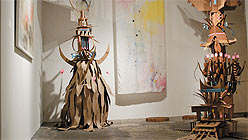This month at the Root Division gallery we were surprised and titillated to find the work of eleven artists who were inspired by the word diorama. And we actually learned a few things (Rachael Posnak taught us that 130 people are killed every year by deer, and that bears have threesomes). Apparently ‘diorama’ does not represent an outdated teaching tool to the artists engaging in this exercise: the works on view are ludicrous and playful, studies in scale that bounce between reality and imagination.
Posnak presents the most classic take on the diorama in miniature worlds that are exquisitely crafted and fully believable. Five glass cubes encase perfect slices of layered, mossy earth with sprouts of trees no bigger than a thimble. The materials are straight out of a toy hobby shop, and yet the scenes are defamed by sex and violence — a man spotting a lion with binoculars is looking for his bloody missing leg, while in the next display an elephant adds another body to a pile of trampled victims. “When they need to” the text informs us, “elephants can walk almost silently.” We, the audience, placed at god-level, find this very funny.

Rachael Posnak, Bears Mate, 2012.
Michael Campbell works similarly with miniature figures, and his small, globular pieces present lonely and enigmatic fantasies. Posthuman shows a 50’s-era futurist man emerging from a cavern of crystal. Small fungi sprout on the opposite side, encased in glass. Home Sweet Home bears a man hanging himself from a spindly tree. His cabin teeters off the edge of a compact silvery globe. The world grows smaller behind him as he reaches his death.
Curators Alexis Arnold and Lauren Hartman have paired three-dimensional work with flat pieces that toy with the idea of space. Brynda Glazier’s trilogy of collages that require 3D glasses are novel with the glasses on and without. Reds and blues vibrate at the edge of clouds, eyeballs, a sea of anenomes and a creepily faceless yeti. And Elisheva Biernoff chips into her painting itself, cutting away layers of wallpaper to reveal wood lathe and a small shelf with an ancient photograph and matchbook (“Chapman Park Hotel”). The whole of Biernoff’s Hiding Place II is a construct of photo-realist painting down to the edges of sheared wallpaper and smudges of dirt on top. It suggests a memory both dear and untrustworthy.



